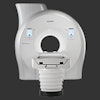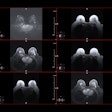
Non-Hispanic Black and Hispanic children are significantly less likely to receive a diagnostic imaging study when visiting an emergency department (ED) than non-Hispanic white patients, according to analysis of over 13 million pediatric ED visits published online January 29 in JAMA Network Open.
A team of researchers led by Dr. Jennifer Marin of the University of Pittsburgh School of Medicine found that at least one imaging study was performed in approximately one-third of visits by non-Hispanic white patients under the age of 18, compared with about one-quarter of visits by non-Hispanic Black and Hispanic children.
"Further investigation is needed to understand and mitigate these potential disparities in health care delivery and to evaluate the effect of these differential imaging patterns on patient outcomes," the authors wrote.
The researchers evaluated data from 13,087,522 ED visits from 6,230,911 children, encompassing all ED visits by patients younger than 18 at 44 tertiary children's hospitals in the U.S from January 1, 2016, to December 31, 2019. Of these visits, 3,689,163 (28.2%) included one or more imaging studies.
Radiography was performed in 79.9% of these visits, followed by ultrasound (19.6%), CT (10.6%), and MRI (2.4%). More than one imaging modality was performed in 339,403 visits (9.2%), according to the researchers.
They found that non-Hispanic white children received imaging in 33.5% of visits, compared with 26.1% of visits by Hispanic children and 24.1% of visits by non-Hispanic Black children. The researchers then calculated odds ratios for receiving imaging studies in comparison with non-Hispanic white children, both overall and after adjusting for confounders such as age, sex, weekend presentation, hour of presentation, insurance, hospital admission, intensive care unit admission, hospital site, complex chronic conditions, year, distance from hospital, and three-day revisit.
| Odds ratios for receiving an imaging study compared with non-Hispanic white children | ||
| Hispanic children | non-Hispanic Black children | |
| Overall | 0.66 | 0.60 |
| After adjusting for confounders | 0.87 | 0.82 |
| Nonhospitalized patients, adjusting for confounders | 0.84 | 0.79 |
There are significant racial and ethnic differences in diagnostic imaging rates among children seeking care in pediatric EDs in the U.S., the authors concluded.
"These differences persist across insurance groups and in analyses limited to discharged children," they wrote. "Further investigation is needed to better understand the factors underpinning these disparities, with the goal of developing measurable interventions to mitigate the disparities in ED imaging and allowing for more equitable and improved care."
Although the appropriateness of the imaging studies wasn't assessed in the study, the researchers suspect that the differences were largely driven by unnecessary testing among white patients. Marin and colleagues noted that prior research in the literature reported examples of more frequent imaging in white children -- with no differences in clinical outcomes -- compared with other races.
In an accompanying invited commentary, Dr. Anupam Kharbanda of Children's Minnesota said that the racial disparity found in this study wasn't a surprise, as it is consistent with decades of previous research documenting inequities in healthcare delivery based on race or ethnicity.
"As the U.S. grapples with a pandemic that has disproportionately affected Black, Hispanic, and Native American communities and highlighted persistent health disparities, there is an urgent need to promote equity in healthcare delivery," he wrote. "In a 1966 speech, the late Dr. Martin Luther King Jr. said, 'Of all the forms of inequality, injustice in health care is the most shocking and inhumane.' We need to hear and believe these words and then work in partnership with the communities we serve to address structural racism in healthcare."



















